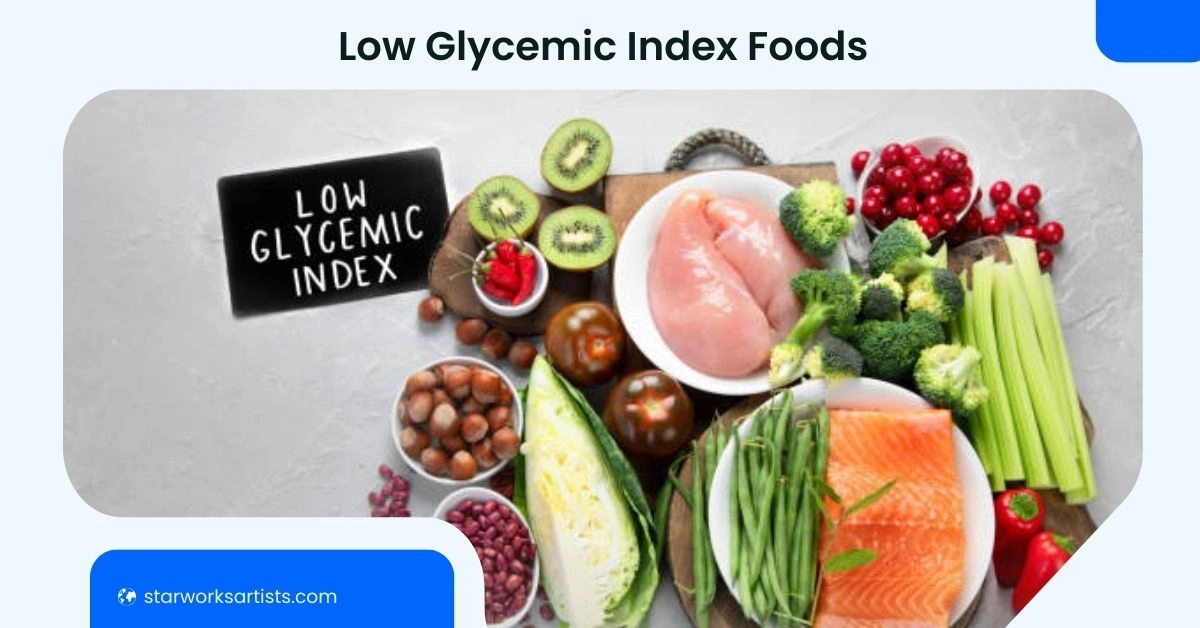In today’s high-speed environment, where convenience frequently takes precedence over nutrition, it’s essential to be attentive to the foods we ingest and their consequences for our health. One crucial aspect to consider is the glycemic index (GI), a measure of how quickly a particular food raises blood sugar levels. Low-glycemic foods have been shown to provide numerous health benefits, making them an ideal choice for individuals seeking to maintain steady blood sugar levels and promote overall well-being.
The glycemic index is a valuable tool that can help us make informed decisions about the carbohydrates we consume. By understanding the glycemic index, we can better navigate the complex world of nutrition and make choices that support our health goals.
Key takeaways
What Is A Glycemic Index?
The glycemic index (GI) is a numerical value assigned to carbohydrate-containing foods based on how quickly they raise blood sugar levels. It measures the impact of a specific food on blood glucose levels compared to a reference food, typically pure glucose or white bread.

Foods with a low GI value (55 or less) are digested and absorbed more slowly, resulting in a gradual and sustained rise in blood sugar levels. On the other hand, high-GI foods (70 or higher) are rapidly digested and cause a sharp spike in blood sugar levels, followed by a rapid decline.
How Glycemic Index Is Measured?
The glycemic index is determined through scientific testing, where a group of healthy individuals consume a specific food containing a fixed amount of carbohydrates (usually 50 grams). Their blood sugar levels are then monitored and compared to the response elicited by consuming an equal amount of pure glucose or white bread.
The food’s GI value is calculated based on the incremental area under the blood glucose response curve over a two-hour period. This value is then expressed as a percentage of the response to the reference food (glucose or white bread, which has a GI of 100).
It’s important to note that factors such as processing methods, ripeness of fruits, and cooking techniques can influence the GI of a food. Additionally, individual responses to different foods may vary due to factors like age, body composition, and overall health status.
Which Are The Low-Glycemic Foods?
Low-glycemic foods encompass a wide range of nutritious options that can help maintain stable blood sugar levels. Here are some examples:
➡️Fruits
➡️Vegetables
➡️Whole Grains
➡️Legumes
➡️Dairy and Dairy Alternatives
➡️Nuts and Seeds
➡️Proteins
Additionally, some low-glycemic foods, like avocados, olives, and extra virgin olive oil, are rich in healthy fats and can contribute to maintaining a healthy diet.
Benefits Of Having Low Glycemic Foods
Relying on the glycemic index can provide several potential benefits:
✅Blood Sugar Control: Low-GI foods help regulate blood sugar levels, reducing the risk of spikes and crashes, which is particularly beneficial for individuals with diabetes or insulin resistance.
✅Weight Management: Low-GI foods tend to be more filling and satisfying, contributing to a feeling of satiety and potentially reducing overall calorie intake. Thus they also help in healthy weight loss.
✅Improved Energy Levels: By avoiding rapid fluctuations in blood sugar levels, low-GI foods can provide sustained energy throughout the day, reducing fatigue and cravings.
✅Reduced Risk of Chronic Diseases: Studies have suggested that following a low-GI diet may help lower the risk of developing chronic conditions like type 2 diabetes, heart disease, and certain types of cancer.
What Are The Glycemic Load And Glycemic Index?
While the glycemic index (GI) measures the impact of a specific food on blood sugar levels, the glycemic load (GL) provides a more comprehensive assessment by considering both the GI and the amount of carbohydrates present in a typical serving.
The glycemic load, as reported by ScienceDirect, is calculated by multiplying the GI value of a food by the amount of available carbohydrates in a serving, divided by 100. This calculation helps account for the fact that some low-GI foods may still contain a significant amount of carbohydrates, potentially affecting blood sugar levels.

By considering both the GI and the serving size, the glycemic load offers a practical approach to meal planning and making informed choices about the overall impact of a meal or snack on blood sugar levels.
Importance Of Glycemic Index In People With Diabetes
The glycemic index plays a crucial role in the management of diabetes, as it directly impacts blood sugar levels and overall metabolic health.
For individuals with diabetes, maintaining stable blood sugar levels is essential to prevent complications such as nerve damage, kidney disease, and cardiovascular risks. High blood sugar levels can lead to a range of health problems, while frequent fluctuations in blood sugar can contribute to fatigue, mood swings, and an increased risk of developing long-term complications.
By incorporating low-glycemic foods into their diet, individuals with diabetes can better control their blood sugar levels and reduce the need for insulin or medication. These foods are digested and absorbed more slowly, resulting in a gradual and sustained release of glucose into the bloodstream, preventing sudden spikes and dips in blood sugar levels.
Best Low Glycemic Foods For Diabetics
Ensuring stable blood sugar levels is vital for individuals managing diabetes, as it helps in controlling the condition and mitigating risks of complications. Low-glycemic foods play a vital role in achieving this goal.
Some of the best low-glycemic food options for diabetics include:
It’s essential for individuals with diabetes to work closely with a healthcare professional or a registered dietitian to develop a personalized meal plan that incorporates low-glycemic foods while considering individual factors such as medication, activity levels, and overall health status.
Should You Avoid High GI Foods Completely?
While high-glycemic index foods should be limited in a diabetic diet, there may be certain situations where their consumption is appropriate or necessary. These include:
It’s important to note that the glycemic index should be used as a guide and not the sole determinant of dietary choices for individuals with diabetes. Other factors, such as portion sizes, overall nutrient content, and individual responses, should also be considered. Working closely with a healthcare professional or a registered dietitian can help develop a personalized meal plan that balances the glycemic index with other dietary considerations.
Conclusion
Understanding the glycemic index and incorporating low-glycemic foods into your diet can have significant benefits for maintaining stable blood sugar levels and promoting overall health. By making informed choices and relying on reputable sources like the National Institutes of Health (NIH) and the Centers for Disease Control and Prevention (CDC), you can make positive dietary changes that support your well-being.
Remember, while the glycemic index is a valuable tool, it should be considered alongside other nutritional factors and personalized recommendations from healthcare professionals. A balanced and varied diet that emphasizes nutrient-dense, low-glycemic foods can contribute to better blood sugar control, reduced risk of chronic diseases, and improved overall health.
FAQs
Foods that are high in protein and healthy fats, like meat, eggs, fish, avocados, and olives, have minimal or no impact on blood sugar levels and are not assigned a glycemic index value.
Yes, eggs are considered a low-glycemic food as they are primarily composed of protein and have a minimal impact on blood sugar levels.
Filling low-glycemic foods include legumes (lentils, chickpeas, beans), nuts, seeds, avocados, and high-fiber fruits and vegetables, which can promote satiety and help with weight management.
The five worst foods for blood sugar are sugary drinks, white bread, pastries, fried foods, and highly processed snacks, as they are typically high in refined carbohydrates and can cause rapid spikes in blood sugar levels.
Natural peanut butter is considered a low-glycemic food, as it is high in protein and healthy fats, which can help regulate blood sugar levels. However, it’s important to check the label and choose varieties without added sugars or unhealthy oils.




